How To Give Fair Feedback Using A Performance Review Platform
Providing fair feedback is a crucial aspect of employee development, ensuring that individuals receive constructive insights that drive their growth. In a corporate environment where performance evaluations are necessary, using a performance review app can streamline the process and promote objectivity. By leveraging HR performance management software, managers can ensure that reviews are data-driven, transparent, and aligned with company goals.
Understanding Fair Feedback
Fair feedback is balanced, objective, and constructive. It acknowledges an employee’s strengths while also addressing areas that need improvement. When feedback is biased or unclear, it can demotivate employees and create misunderstandings. A structured approach, supported by a performance review platform, allows managers to assess employees based on measurable criteria rather than personal opinions. To provide fair feedback, it is essential to base evaluations on factual performance data, align feedback with specific job roles and responsibilities, maintain a consistent approach for all employees, and encourage open communication for clarification and discussion.
Using A Performance Review Platform For Objectivity
Traditional performance reviews often rely on subjective observations, which can lead to inconsistencies. A performance review platform provides a structured framework that ensures each employee is evaluated fairly. These platforms collect performance data over time, reducing reliance on memory and perception-based assessments. With built-in analytics and reporting tools, managers can compare an employee’s progress against predefined key performance indicators (KPIs). This eliminates bias and ensures that employees receive feedback based on their actual performance rather than recent interactions or personal relationships.
Benefits Of HR Performance Management Software
Implementing HR performance management software helps companies enhance their performance review processes by making them more systematic and efficient. Standardisation of reviews ensures that all employees are evaluated based on the same criteria, reducing inconsistencies. Data-driven insights provide real-time performance data, allowing managers to make informed decisions. A continuous feedback mechanism encourages ongoing performance discussions rather than limiting them to annual reviews. Goal alignment helps employees understand their contribution to company objectives, increasing motivation. These features make HR performance management software a valuable tool for fostering a culture of continuous improvement within an organisation.
Providing Constructive And Actionable Feedback
Constructive feedback should be specific, goal-oriented, and focused on professional development. A structured performance review platform allows managers to document observations and suggest improvement strategies in a systematic manner. Employees should receive feedback that not only highlights areas of improvement but also provides actionable steps to enhance their performance. Managers should focus on specific examples rather than general observations, offer guidance on how employees can improve, recognise achievements to maintain motivation, and encourage a two-way conversation for better understanding.
Encouraging Employee Participation In Reviews
Feedback should not be a one-sided conversation. Employees must have the opportunity to share their perspectives, ask questions, and discuss their challenges. A performance review platform facilitates this by allowing employees to self-assess and provide input before receiving their evaluation. By fostering an open dialogue, organisations create a work environment where employees feel valued and heard. This increases engagement and helps employees take ownership of their professional growth.
Conclusion
Providing fair feedback using a performance review platform ensures that employee evaluations are objective, constructive, and data-driven. By incorporating HR performance management software, organisations can enhance transparency, standardisation, and employee development. Encouraging open communication and offering actionable insights will create a more motivated and high-performing workforce.
Get to know more about Happy5 today to build a culture of continuous improvement.















